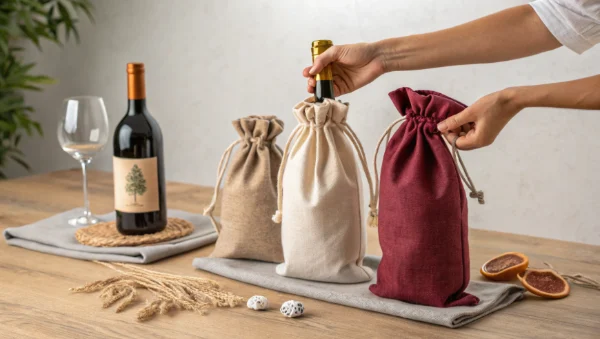
Carrying a bottle of wine by hand often feels a bit too casual. Can a bottle wine bag strike the right balance between aesthetics, convenience, and cost? Let’s break it down together.
What are the pros and cons of bottle wine bags? Bottle wine bags come with both strengths and limitations. On the positive side, they offer attractive appearances, various material options, and support custom printing—making them ideal for gifting and brand promotion. They’re lightweight, easy to carry and store, and some versions are water-resistant. Plus, they’re eco-friendly and cost-effective for a wide range of occasions, from festivals and events to business use. However, they offer limited protection and aren’t designed to withstand heavy impact or pressure. They’re also less suitable for high-end displays or long-term storage, and multi-bottle bags may become uncomfortable to carry if weight is unevenly distributed. When choosing a wine bag, it’s important to consider both the use case and the bag’s structure.
There’s no denying that bottle wine bags offer a lot of practical benefits. Still, they aren’t a one-size-fits-all solution. In this article, we’ll take a closer look at their advantages and disadvantages to help you decide whether they’re the right choice for your needs.

Insulated wine bags are useful for maintaining temperature during picnics or transport. True
They typically include foam and foil layers to help retain cold or moderate temperatures for short periods.
All drawstring wine bags come with inner waterproof linings. False
Most drawstring wine bags do not include inner linings; they rely on the outer fabric alone for structure and presentation.
Compared to a bare wine bottle or a basic paper bag, a bottle wine bag adds a sense of ceremony and refinement to the presentation. With a wide range of materials and colors available, it’s easy to achieve styles that range from rustic and natural to elegant and upscale. This thoughtful touch not only elevates the wine itself but also leaves a stronger impression on the recipient, especially in weddings, holiday gifts, or business events.
Common materials for wine bags include cotton, jute, velvet, Tyvek, and leather—each offering a unique texture and aesthetic. Users can choose the material and design that best fit their needs: jute for eco-friendly themes, velvet for premium occasions, or Tyvek for a lightweight, modern look. This material flexibility allows wine bags to adapt well to different brand tones, customer preferences, and event types.
Most bottle wine bags are made with durable materials that support repeated use, reducing the environmental impact of disposable packaging. Options such as cotton, jute, and Tyvek are either natural or recyclable, which helps extend the life cycle of the product and aligns with today’s growing demand for sustainable packaging. This makes wine bags an ideal choice for eco-conscious brands and events.
Most wine bags are lightweight and designed with convenience in mind. Features like carry handles or drawstring closures make them easy to hold, pack, or store. Compared to rigid boxes or heavy gift sets, a soft fabric wine bag is easier to bring along for travel, business visits, or outdoor events. It’s a practical packaging solution that combines visual appeal with everyday functionality.
Bottle wine bags are typically made from soft, flexible materials that can be folded flat when not in use, taking up minimal storage space. This makes them ideal for bulk orders, shipping, or centralized procurement. Compared to rigid boxes, fabric wine bags adapt more easily to various outer packaging configurations, improving packing efficiency. They are particularly suitable for e-commerce fulfillment, event logistics, and corporate distribution scenarios.
Certain bottle wine bags feature materials with natural resistance to water or stains, such as Tyvek, leather, or laminated fabrics like laminated non-woven, laminated PP woven, or laminated RPET. These materials help prevent liquid seepage and surface staining, making the bags a reliable choice for outdoor events, humid environments, or situations where the wine needs to be chilled. This added functionality not only improves durability but also extends the usable life of the wine bag.
Compared to premium packaging like wooden or leather wine boxes, bottle wine bags offer a more cost-efficient solution in terms of both materials and production. Common fabrics like cotton, linen-like blends, and non-woven fabric are especially budget-friendly while still delivering a clean, attractive appearance. For companies planning holiday gifts, promotional campaigns, or client giveaways, bottle wine bags provide both functionality and visual appeal at a manageable price point—making them ideal for custom wine bag projects in large volumes.
A well-designed wine bag does more than wrap a product—it elevates the entire unboxing experience. From the look and feel to practical usability, wine bags often become part of the gift itself. When thoughtfully crafted, they reflect attention to detail and professionalism, helping brands leave a lasting impression. This makes them especially valuable in brand activations, custom wine promotions, and high-frequency gifting scenarios.
Bottle wine bags are highly versatile and can be used across a range of settings—from weddings, birthdays, and holiday gifts to corporate events, client thank-you packages, and wine promotions. Whether you’re creating a standalone gift presentation or incorporating wine bags into your broader branding strategy, their adaptability in style and structure makes them suitable for many different types of users and occasions.

Choosing a slightly shorter wine bag can enhance its gift-like appearance. True
A bag that cinches at the bottle neck and reveals part of the cap creates a more intentional and elegant presentation.
Velvet wine bags are only suitable for winter holidays. False
While velvet pairs well with festive seasons, it can also be used for luxury gifts and business events throughout the year.
While most bottle wine bags offer basic cushioning, their soft structure isn’t designed to withstand strong impacts or long-distance transport involving heavy pressure. Compared to hard-shell wine cases or professional wine shipping boxes, fabric wine bags are better suited for short-distance hand-carry use or event display. If dropped or subjected to force, bottles inside may still be at risk. Users should carefully assess the application scenario before choosing this type of packaging.
Although bottle wine bags work well for everyday gifting and casual presentation, they may fall short in formal or high-end settings. Unlike wooden or leather wine boxes, soft bags typically lack the structure and presence needed for luxury positioning or collectible display. For high-value wine or occasions that require a strong visual statement, more rigid packaging is often recommended.
Bottle wine bags are primarily intended for short-term use. Their soft construction doesn’t provide the stable environment required for long-term wine storage, nor do they offer protection against light, dust, or temperature fluctuations. Visually, they also lack the permanence and structure of a formal display box. As a result, they are not an ideal substitute for premium gift sets or long-term shelving in retail or private collections.
Bottle wine bags are highly functional—but not universally suitable. Their strengths shine in specific situations, while their limitations make them less ideal in others. Understanding when to use them can help you make smarter sourcing and packaging decisions.
For long-haul transportation, luxury wine presentations, or temperature-sensitive storage, bottle wine bags may not offer the protection or structure required. In such cases, we recommend using rigid boxes or specialized wine shipping solutions.

Choosing a wine bag with dividers helps protect multiple bottles during transport. True
Dividers prevent bottles from colliding, making multi-bottle bags safer for transport and display.
Wine bags made from Tyvek are completely biodegradable. False
Tyvek is made from HDPE, which is recyclable but not biodegradable.
Bottle wine bags offer a smart combination of visual appeal, portability, and customizable structure—making them a versatile packaging solution across a wide range of gifting and promotional needs. However, their soft form and limited protection make them less suitable for high-end display or heavy-duty logistics. By understanding both the advantages and limitations, you’ll be better equipped to choose the right wine packaging for your specific goals.
If you’re looking for a bottle wine bag that combines aesthetic appeal with functional design, Yanxin Bag offers a wide range of options with customizable materials and structures. As a trusted custom wine bag manufacturer, we provide multi-dimensional customization—covering sizes, construction, and printing—to support gifting, branding, and retail needs. Contact Yanxin Bag wine bag factory today for tailored solutions and a detailed quote that helps you elevate your wine packaging experience.
1Explore how eco-conscious design influences packaging decisions, promoting sustainability and appealing to environmentally aware consumers.
2Learn about the advantages of having multiple bottle compartments for convenience and organization.
3Check out this resource for creative wedding favor ideas that will impress your guests.
Answer: Bottle wine bags are ideal for gifting and short-term use, but they are not recommended for high-end wine display or long-term wine storage. Their soft structure lacks the rigidity and environmental control needed for preserving premium wines.
Answer: Materials like Tyvek, faux leather, and laminated fabrics provide excellent water-resistant and stain-repellent properties, making them ideal for wine bags used in outdoor or humid conditions.
Answer: Compared to wooden boxes or premium packaging, wine bags made from cotton, jute, or non-woven fabric are more affordable. Their lower production cost and compact foldable design make them perfect for bulk procurement.
Answer: Wine bags come in various styles such as drawstring wine bags, tote-style wine bags, single-bottle pouches, and multi-bottle carriers. Each type suits different occasions, from weddings to corporate gifting.
Answer: Tyvek wine bags are lightweight, tear-resistant, and have a modern aesthetic, making them suitable for creative brand promotions and pop-up events. Jute wine bags, on the other hand, convey a natural and eco-friendly brand image.
Answer: Drawstring wine bags offer easy closure, reusable structure, and a soft, premium look. They are popular for holiday gifts due to their blend of practicality and elegance.
Answer: Wine bags are widely used in winery retail, festive gift sets, ecommerce packaging, wedding favors, and corporate giveaways. They offer both practicality and brand exposure.
Answer: Look for a custom wine bag manufacturer with proven experience, low MOQ flexibility, sample support, fast turnaround times, and clear communication. These factors ensure smooth order execution and consistent quality.
Answer: Store in a dry, well-ventilated area away from moisture. For fabrics like cotton, velvet, or linen, ensure the bags are cleaned and air-dried before storing to prevent odor or mildew.

Order or no-order we are Always here to help you!
We will contact you within 1 working day, please pay attention to the email with the suffix “@yanxinbag.com”.
Order or no-order we are Always here to help you!
We will contact you within 1 working day, please pay attention to the email with the suffix “@yanxinbag.com”.